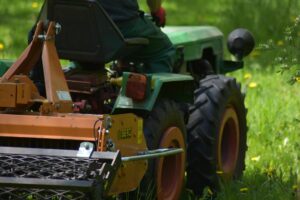Tractors are indispensable tools for farmers, landscapers, and property owners, helping tackle everything from plowing fields to hauling heavy loads. Tractor maintenance tips is important for owner.
However, to keep your tractor in peak condition and ensure its longevity, regular maintenance is essential. Neglecting proper care can lead to costly repairs, reduced efficiency, and downtime during critical work periods. In this guide, we’ll cover essential tractor maintenance tips every owner should know, helping you preserve your investment and maximize its performance.
Why Tractor Maintenance Matters
Regular maintenance keeps your tractor running smoothly, reduces the risk of breakdowns, and extends its lifespan. Here are some key benefits of proper tractor care:
Longevity: Proper care ensures your tractor serves you reliably for years.
Efficiency: A well-maintained tractor performs better, saving you time and fuel.
Safety: Regular inspections help identify potential issues that could lead to accidents.
Cost Savings: Preventative maintenance avoids costly repairs and minimizes downtime.
14 Top Tractor Maintenance Tips
1. Start with the Owner’s Manual
Your tractor’s owner’s manual is the most valuable resource for maintaining your machine. It provides detailed information about the manufacturer’s recommended maintenance schedule, parts specifications, and operating instructions.
Key Sections to Review
- Maintenance intervals for filters, fluids, and components.
- Recommended types of engine oil, transmission fluid, and coolant.
- Instructions for safely handling and operating your specific tractor model.
Always refer to the manual before attempting repairs or replacements to avoid voiding warranties or causing damage.
2. Perform Regular Oil Changes
Changing the oil is one of the most critical aspects of tractor maintenance. Engine oil lubricates moving parts, reduces friction, and prevents overheating.
Oil Change Tips
- Check the oil level before each use using the dipstick.
- Replace the oil and oil filter as recommended in the owner’s manual, typically after every 100-200 hours of operation.
- Use the correct grade of oil specified by the manufacturer for optimal performance.
Neglecting oil changes can lead to engine wear, decreased efficiency, and costly repairs.
3. Inspect and Replace Filters
Filters play a crucial role in protecting your tractor’s engine and hydraulic systems by preventing dirt and debris from entering critical components.
Filters to Maintain
- Air Filter: Inspect regularly, especially in dusty conditions. Clean or replace the filter to ensure proper airflow to the engine.
- Fuel Filter: Replace the fuel filter periodically to maintain fuel system efficiency and prevent contaminants from clogging injectors.
- Hydraulic Filter: Check and replace the hydraulic filter as part of the routine maintenance schedule.
Clean filters improve performance, reduce emissions, and protect the engine from damage.
4. Monitor Fluid Levels
Your tractor relies on various fluids to operate efficiently. Regularly checking and topping off these fluids is essential.
Key Fluids to Check
- Engine Oil: Ensures smooth engine operation and prevents overheating.
- Coolant: Maintains the engine’s operating temperature and prevents overheating.
- Transmission Fluid: Keeps the transmission system running smoothly and prevents gear wear.
- Hydraulic Fluid: Powers attachments and other hydraulic components. Low hydraulic fluid can cause sluggish performance or system failure.
Always use fluids that meet the manufacturer’s specifications and check for leaks regularly.
5. Check Tire Pressure and Condition
Proper tire maintenance improves traction, fuel efficiency, and stability. Tires in poor condition can cause uneven wear, reduce productivity, and increase the risk of accidents.
Tire Maintenance Tips
- Inspect tires for cuts, cracks, or excessive wear.
- Check tire pressure regularly and adjust it to the recommended PSI.
- Rotate tires periodically to ensure even wear.
For tractors used on uneven terrain, ensure the tires have enough tread depth for optimal grip.
6. Keep the Battery in Top Shape
A healthy battery is essential for starting your tractor and powering its electrical systems. Battery neglect can leave you stranded at the worst possible time.
Battery Maintenance Tips
- Inspect battery terminals for corrosion and clean them with a baking soda solution if necessary.
- Check the battery’s charge and fluid levels (for non-sealed batteries).
- Keep the battery securely mounted to avoid vibrations that can damage internal components.
- Replace old or weak batteries promptly to avoid unexpected failures.
Store the tractor in a sheltered location during extreme weather to prolong battery life.
7. Maintain the Cooling System
The cooling system prevents your tractor’s engine from overheating, especially during heavy-duty work.
Cooling System Maintenance
- Check the coolant level before each use and top it off as needed.
- Inspect the radiator for debris, leaks, or damage.
- Clean the radiator fins with compressed air to ensure proper airflow.
Replace coolant according to the manufacturer’s schedule to avoid corrosion and maintain efficient cooling.
8. Inspect Belts and Hoses
Belts and hoses are critical for operating various components, including the engine, alternator, and cooling system.
What to Look For
- Check belts for cracks, fraying, or signs of wear. Replace worn belts promptly to avoid unexpected failures.
- Inspect hoses for leaks, soft spots, or bulges. Damaged hoses can lead to fluid leaks and overheating.
Regular inspection and timely replacement of belts and hoses prevent costly breakdowns.
9. Grease Moving Parts
Tractors have many moving parts that need lubrication to reduce friction and wear.
Greasing Tips
- Use a grease gun to apply grease to fittings on joints, bearings, and other moving parts.
- Follow the lubrication schedule in your owner’s manual to avoid over- or under-lubricating components.
- Clean grease fittings before applying grease to prevent contaminants from entering.
Well-lubricated parts improve performance and extend the life of your tractor.
10. Clean Your Tractor Regularly
Keeping your tractor clean not only enhances its appearance but also prevents long-term damage.
Cleaning Tips
- Remove dirt, mud, and debris from the undercarriage, wheels, and body after each use.
- Use compressed air to clean the engine compartment and radiator fins.
- Wash your tractor with mild soap and water, avoiding high-pressure washers that can damage seals or electrical components.
A clean tractor is easier to inspect for potential issues and runs more efficiently.
11. Perform Seasonal Maintenance
Tractors used seasonally need special care during off-season storage and preparation for the next season.
Winter Storage
- Drain water from the cooling system and use antifreeze to prevent freezing.
- Disconnect the battery and store it in a dry, warm place.
- Cover the tractor to protect it from dust, moisture, and rodents.
Spring Preparation
- Inspect all components for wear or damage before use.
- Top off fluids and replace filters as needed.
- Perform a full systems check to ensure everything is operational.
12. Keep a Maintenance Log
Maintaining a detailed log of all maintenance tasks helps you stay organized and ensures nothing is overlooked.
What to Track
- Dates of oil changes, filter replacements, and fluid checks.
- Repairs and part replacements.
- Notes on unusual sounds, vibrations, or performance issues.
A maintenance log helps identify recurring issues and ensures timely servicing.
13. Use Quality Replacement Parts
Always use genuine or high-quality replacement parts that meet the manufacturer’s specifications. Inferior parts may save money initially but can lead to poor performance and damage over time.
14. Stay Alert for Warning Signs
Pay attention to unusual noises, reduced performance, or warning lights on your tractor. Addressing minor issues promptly prevents them from escalating into major problems.
Conclusion
Regular maintenance is essential for keeping your tractor in optimal condition, ensuring its reliability and performance. By following these tractor maintenance tips every owner should know, you can prevent costly repairs, extend your tractor’s lifespan, and maximize its efficiency.
Whether you’re a seasoned farmer or a first-time tractor owner, investing time in routine care will pay off in the long run. Remember, a well-maintained tractor is not just a machine—it’s a trusted partner in your work and livelihood.




Pingback: Understanding Tractor Technology: A Beginner’s Guide
Pingback: Comparing Tractors: Which Model is Right for You?
Pingback: Agricultural Tractor Tyres: A Complete Guide to Choosing the Right Tyres